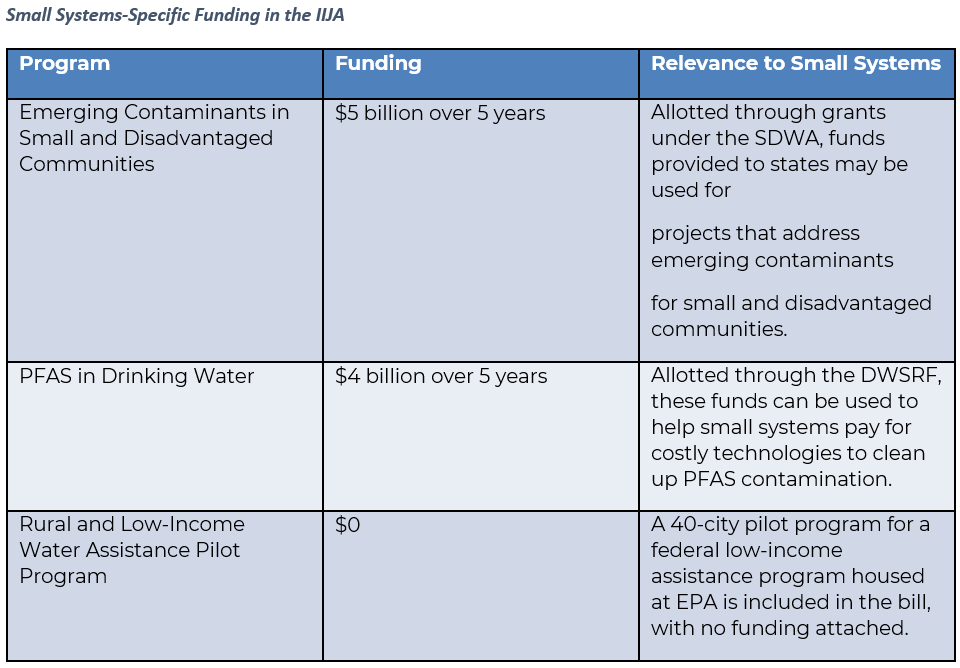The Infrastructure Investment and Jobs Act (IIJA) was signed into law on November 15, 2021. This legislation includes $50 billion for water/wastewater infrastructure, distributed over 5 years, and the allocations per state were released in early December. There are some great overviews regarding the IIJA here, here, or here, and one could spend hours reading about all the excitement, but how will all these dollars make their way to small systems specifically and how can those utilities begin preparing now?
Small-System Specific Funding?
Most of the funds will be distributed through the Drinking Water and Clean Water State Revolving Fund (DWSRF and CWSRF) programs, which are administered by each state. These programs provide low-interest loans to utilities for infrastructure projects. Many projects are eligible, though debt service and operation and maintenance expenses are not. However, planning and design work is an eligible expense, so it’s okay to apply for funding even if you don’t have a “shovel ready” project. SRF staff can also serve as valuable resources for systems that want to learn about how they can use IIJA funding. The IIJA allocates 49% of the SRF funds to be spent on disadvantaged communities, though the criteria for identifying disadvantaged communities varies by state. These criteria can be found on states’ SRF program websites, and if you’d like to check out different states, the Southwest EFC’s SRF switchboard is a great way to look up priority lists, criteria, intended use plans, and legislation.
However, the IIJA includes some funding sources specific to small systems. Five billion dollars is allocated to the Small and Disadvantaged Communities grant program to address emerging contaminants. Eligible projects include investments needed for Safe Drinking Water Act (SDWA) compliance, household water quality testing, and assistance that primarily benefits a community on a per-household basis. A project in a small community is eligible for assistance if the population served is less than 10,000 individuals and is unable to incur debt sufficient to finance a project to comply with the SDWA.
IIJA also addresses advanced drinking water technologies, requiring the EPA to establish a grant program for water systems either serving 100,000 or fewer individuals or small and disadvantaged water systems to identify and deploy these technologies.
Though it will need to be funded by subsequent appropriations legislation, IIJA establishes a Rural and Low-Income Water Assistance Pilot Program intended to assist eligible households in maintaining access to drinking water and wastewater services. These funds should bolster existing affordability or bill assistance programs through “direct financial assistance, a lifeline rate, bill discounting, special hardship provisions, a percentage-of-income payment plan, or debt relief for eligible [entities].” A maximum of forty programs will be awarded with provisions to ensure eligible entities represent a variety of service populations. Additionally, priority will be given to communities who “serve a disproportionate percentage … of qualifying households” with need.
States will prioritize projects potentially more in line with the Biden administration’s #Justice40 commitment, which aims to send 40 percent of federal investments to disadvantaged communities. In addition, the IIJA directs the EPA to study the historical distributions of funds to small and disadvantaged communities and identify opportunities to improve distribution to low-income, rural, minority, and indigenous communities.
What are the Big Takeaways for Small Systems?
No doubt, the IIJA allocates an enormous amount of dollars for programs designed to improve our water, wastewater, and stormwater systems. Since the funds are already allocated, they should be distributed to the states quickly, so states and localities need to act fast to identify and execute projects. For smaller utilities looking to equip themselves for this influx of funding, affordability challenges, along with financial and programmatic capacity issues, can be of particular concern, but these issues can be mitigated by planning ahead.
While funding will help address critical capital needs for safety and resilience, affordability will still be a challenge for many because most federal funding comes in the form of low-interest loans that may need to be repaid. The rising cost of water and wastewater services and the ability of households to afford them are issues facing small communities across the country. State-funded assistance programs could help customers with high bills while allowing utilities to make needed investments, but no funding was included for such a program in the IIJA.
IIJA will mean greater demand for skilled workers and input materials, and systems must be prepared to meet these challenges. Local governments, as the owners and operators of most infrastructure, must design and build new assets, hire more workers, and even mobilize their own financial resources. Utilities can explore opportunities for regional partnerships—if applying for funds feels like too much for one utility, a regional entity may be able to help. The Environmental Finance Center Network and regional councils of governments have experience offering assistance to systems looking to consolidate multiple aspects of their services.
Finally, utilities should keep in mind the long-term financial sustainability of the system, planning ahead now to determine how they will cover operational and maintenance expenses for infrastructure projects in the decades to come. Asset management plans, which lay out the current state of your infrastructure and prioritize projects, can provide an understanding of financial sustainability and are specifically listed as an eligible use of funds under the IIJA language. Before the money is dispersed, water utilities should determine which projects are priorities, keeping in mind that the IIJA includes specific funding for lead service line replacement and addressing emerging contaminants. The Environmental Finance Center Network is a great resource for technical assistance and guidance on what types of projects may be the most beneficial for a utility so don’t hesitate to reach out!

